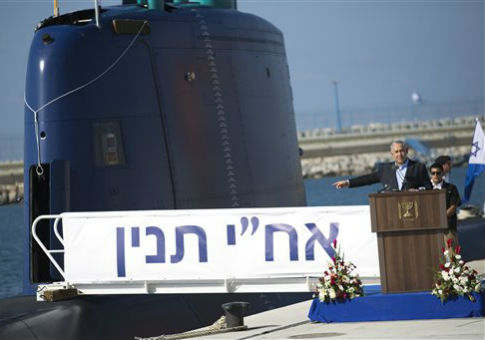JERUSALEM—With a possible agreement on Iran’s nuclear program approaching, the Israeli navy today hosted military reporters on a tour of its latest submarine, part of an underwater fleet reportedly armed with nuclear-tipped cruise missiles that will serve as Israel’s major deterrent against a nuclear-armed Islamic Republic.
The submarine, the INS Tanin (in English, "Crocodile") is one of five acquired from Germany in the past two decades.
According to foreign reports, cruise missiles aboard the vessels have a range of close to 1,000 miles and can carry nuclear warheads. Capable of extended stays at sea, one or more of submarines would likely always be within range of Iran.
Although Israel is reported to have some 80 nuclear weapons, these are seen only as "doomsday" options.
Meir Dagan, a former Mossad chief who opposed a preemptive Israeli air strike against Iran’s nuclear facilities, has said that such an attack should be carried out "only when the sword is at the throat." Although the prospect of an Iranian nuclear weapon has raised fears in Israel, many find comfort in the second-strike capability provided by the submarines that, they believe, make it unlikely that Iran would attack Israel with nuclear weapons.
Although Israel still presumably has the ability to derail the Iranian program by a conventional air attack, it is now considered doubtful that it will attempt such an operation. If Tehran strikes a deal, an Israeli preemptive attack is considered even more unlikely since that would mean challenging not only Iran but the U.S. and its European allies.
The first two of the Dolphin-class vessels, among the most sophisticated conventionally powered submarines in the world, were fully paid for by Germany. Ostensibly, this was because of revelations after the first Gulf War in 1991 that German firms had assisted Iraq in modernizing its missile arsenal, which was used to target Israel. It was widely believed that guilt stemming from the Holocaust also played a part in Germany’s decision.
The subsequent submarines, each costing a reported half a billion dollars, were heavily subsidized by the German government.
Iran, however, still poses a significant threat to Israel in terms of conventional warfare. With its help, Hezbollah in Lebanon now has some 100,000 rockets. The Islamic Republic has also supplied rockets to Hamas in Gaza, many of which were fired into Israel during last summer’s war. It has also provided both organizations with military advisers and has brought Hezbollah and Hamas fighters to train in Iran itself.
Late last year, the threat from Iran became more direct when Israel learned that Tehran’s Revolutionary Guards were involved in helping Hezbollah set up a new front against Israel on Syrian territory opposite the Golan Heights. The Iranians created an elite unit for this purpose made up of Hezbollah veterans, Palestinians, and Syrians who underwent intense training under Iranian supervision. The Revolutionary Guards also set up a logistical network to support the unit.
In an Israeli air strike in January on two vehicles reconnoitering the Golan border, 12 men were killed, six from Hezbollah and six from the Revolutionary Guards, including a general.
The Iranians played a central advisory role in an offensive launched earlier this year by the Syrian regime in conjunction with Hezbollah against rebel forces in southern Syria, between the Golan and Jordanian borders. Thousands of Shiite fighters were brought by Iran from Iraq, and reports indicated that fighters from Afghanistan were involved as well. This effort, however, has stalled with no gains of consequence to show after three months.
The Israeli military and intelligence services braced for further attempts by Iran to destabilize the border areas.
